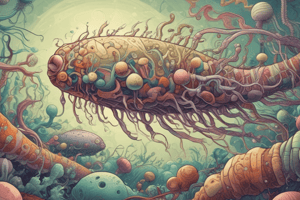Podcast
Questions and Answers
Which type of microorganism is characterized by prokaryotic cells?
Which type of microorganism is characterized by prokaryotic cells?
- Bacteria (correct)
- Protists
- Fungi
- Archaea
In which type of environment do archaea thrive?
In which type of environment do archaea thrive?
- Deep sea vents (correct)
- Forests
- Freshwater lakes
- Human bodies
Which microorganism type has DNA contained in a nucleus enclosed by a membrane?
Which microorganism type has DNA contained in a nucleus enclosed by a membrane?
- Archaea
- Bacteria
- Protists
- Fungi (correct)
Which type of microorganism consists of unicellular yeasts and multicellular mushrooms?
Which type of microorganism consists of unicellular yeasts and multicellular mushrooms?
Where can bacteria be found according to the text?
Where can bacteria be found according to the text?
Which microorganism type is involved in processes like photosynthesis and nitrogen fixation?
Which microorganism type is involved in processes like photosynthesis and nitrogen fixation?
What is a key role of fungi in the environment?
What is a key role of fungi in the environment?
Which of the following is a type of fungi-related illness in humans?
Which of the following is a type of fungi-related illness in humans?
Where do most protists primarily live?
Where do most protists primarily live?
What is a common example of a protist?
What is a common example of a protist?
Which microorganism forms symbiotic relationships with plants?
Which microorganism forms symbiotic relationships with plants?
Flashcards are hidden until you start studying
Study Notes
Microorganisms
Microorganisms, also known as microbes, are microscopic life forms that play a crucial role in various ecological processes. They come in diverse shapes and sizes, inhabiting different environments around the world. There are four main types of microorganisms based on their cellular structures: bacteria, archaea, fungi, and protists. Each type has unique characteristics and functions within ecosystems.
Bacteria
Bacteria are single-celled organisms characterized by prokaryotic cells, which lack a nucleus and other membrane-bound organelles. These microorganisms can inhabit almost every environment, from deep sea vents to human bodies. Their diversity is immense, with over 5,000 different species identified so far. Some bacteria are beneficial, such as those used in sewage treatment plants, while others cause diseases like tuberculosis and syphilis.
Archaea
Archaea are also prokaryotes, similar to bacteria. However, they have some differences in cell structure and genetic material. Unlike most bacteria, archaea thrive in extreme environments, such as hot springs, salty lakes, and methane-rich soil. They are involved in vital processes, including photosynthesis and nitrogen fixation.
Fungi
Fungi consist of unicellular yeasts, filamentous molds, and multicellular mushrooms. They have eukaryotic cells - their DNA is contained in a nucleus enclosed by a membrane. Many fungi are decomposers, breaking down dead organic matter and recycling nutrients back into the environment. Others form symbiotic relationships with plants, helping them absorb water and minerals. Some fungi can cause illnesses in humans, such as athlete's foot and ringworm.
Protists
Protists are eukaryotic microorganisms that do not fit neatly into any other category. They come in many varieties, including amoebas, ciliates, flagellates, slime molds, and plasmodium. Most protists live in aquatic habitats, although some are found in soil and on plants. Protists serve essential roles in food chains and decomposition processes.
In conclusion, microorganisms are incredibly diverse and versatile entities that contribute significantly to our planet's health and functioning. Understanding their classification and roles helps us appreciate the complex web of life we live in.
Studying That Suits You
Use AI to generate personalized quizzes and flashcards to suit your learning preferences.




